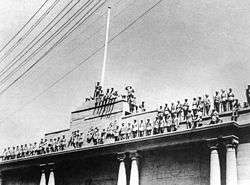Chinese Communist Revolution
The Chinese Communist Revolution, known in mainland China as the War of Liberation (simplified Chinese: 解放战争; traditional Chinese: 解放戰爭; pinyin: Jiěfàng Zhànzhēng), was the conflict, led by the Communist Party of China and Chairman Mao Zedong, that resulted in the proclamation of the People's Republic of China, on 1 October 1949. The revolution began in 1946 after the Second Sino-Japanese War (1937–45) and was the second part of the Chinese Civil War (1945–49).[3]
| Chinese Communist Revolution 中国人民解放战争 (Chinese People's War of Liberation) 反共衛國戡亂戰爭 (National Protection War against the Communist Rebellion) 第二次國共內戰 / 第二次国共内战 (Second Kuomintang-Communist Civil War) | |||||||
|---|---|---|---|---|---|---|---|
| Part of the Chinese Civil War (1927–1949) Part of the Cold War (1947–1950) | |||||||
 People's Liberation Army occupies the Presidential Palace in Nanjing. April, 1949 | |||||||
| |||||||
| Belligerents | |||||||
|
| ||||||
|
| ||||||
| Commanders and leaders | |||||||
| Strength | |||||||
|
| ||||||
| Casualties and losses | |||||||
| 250,000 in three campaigns | 1.5 million in three campaigns[2] | ||||||
Historical background
Some historians have traced the origins of the 1949 Revolution to sharp inequalities in society. John Peter Roberts, for instance, writes that under the Qing dynasty, high rates of rent, usury and taxes concentrated wealth into the hands of a tiny minority of village chiefs and landlords. He quotes the statistic that "Ten percent of the agricultural population of China possessed as much as two-thirds of the land".[4] Many of these historians also argue that China was under heavy colonialist pressure by the Western powers and the Japanese and "Century of Humiliation" starting with the Opium Wars and including unequal treaties, the Boxer Rebellion. This group concludes that extreme internal inequality and external aggression led to a rise in nationalism, class consciousness and leftism among vast swaths of the population.
After internal unrest and foreign pressure weakened the Qing state, a revolt among newly modernized army officers led to the Xinhai Revolution, which ended 2,000 years of imperial rule and established the Republic of China.[5] Following the end of World War I and October Revolution in Russia, labor struggles intensified in China. Workers were fighting for better wages. In Shanghai alone, there were over 450 strikes between 1919 and 1923.[6]
The French historian Lucien Bianco, however, is among those who question whether imperialism and "feudalism" explain the revolution.[7] He points out that the Chinese Communist Party did not have great success until the Japanese invasion of China after 1937. Before the war, the peasantry was not ready for revolution; economic reasons were not enough to mobilize them. More important was nationalism: "It was the war that brought the Chinese peasantry and China to revolution; at the very least, it considerably accelerated the rise of the CCP to power."[8] The communist revolutionary movement had a doctrine, long-term objectives, and a clear political strategy that allowed it to adjust to changes in the situation. He adds that the most important aspect of the Chinese Communist movement is that it was armed.[9]
Founding of the Communist Party of China
The Communist Party of China was founded in 1921, during the May Fourth Movement, which Mao Zedong referred to as the birth of communism in China.[10]
After a period of slow growth and alliance with the Kuomintang (Chinese Nationalist Party), the alliance broke down and the Communists fell victim in 1927 to a purge carried out by the Kuomintang under the leadership of Chiang Kai-shek.[11] After 1927, the Communists retreated to the countryside and built up local bases throughout the country and continued to hold them until the Long March. During the Japanese invasion and occupation, the Communists built more secret bases in the Japanese occupied zones and relied on them as headquarters.[12]
Chinese Civil War, 1945–1949
The Nationalists had an advantage in both troops and weapons, controlled a much larger territory and population, and enjoyed broad international support. The Communists were well established in the north and northwest. The best-trained Nationalist troops had been killed in early battles against the better equipped Japanese Army and in Burma, while the Communists had suffered less severe losses. The Soviet Union, though distrustful, provided aid to the Communists, and the United States assisted the Nationalists with hundreds of millions of dollars' worth of military supplies, as well as airlifting Nationalist troops from central China to Manchuria, an area Chiang Kai-shek saw as strategically vital to retake. Chiang determined to confront the PLA in Manchuria and committed his troops in one decisive battle, the Battle of Liaohsi, in the autumn of 1948. The strength of Nationalist troops in July 1946 was 4.3 million, of which 2.3 million were well-trained and ready for country-wide mobile combat.[13][14][15] However, the battle resulted in a decisive Communist victory and the Nationalists were never able to recover from it.
Result
On October 1, 1949, Chairman Mao Zedong officially proclaimed the founding of the People's Republic of China at Tiananmen Square. Chiang Kai-shek, 600,000 Nationalist troops and about two million Nationalist-sympathizer refugees retreated to the island of Taiwan. After that, resistance to the Communists on the mainland was substantial but scattered, such as in the far south. An attempt to take the Nationalist-controlled island of Kinmen was thwarted in the Battle of Kuningtou. In December 1949 Chiang proclaimed Taipei, Taiwan the temporary capital of the Republic, and continued to assert his government as the sole legitimate authority of all China, while the PRC government continued to call for the unification of all China. The last direct fighting between Nationalist and Communist forces ended with the Communist capture of Hainan Island in May 1950, though shelling and guerrilla raids continued for several years. In June 1950, the outbreak of the Korean War led the American government to place the United States Seventh Fleet in the Taiwan Strait to prevent either side from attacking the other.[16]
Notes
- The conflict did not have an official end date; however, historians generally agree that the war subsided after the People's Republic of China took the Mosquito Tail Islet, the last island held by the Republic of China in the Wanshan Archipelago.[1]
- Kuomintang Islamic insurgency against the People's Republic of China's rule continued in the provinces of Gansu, Qinghai, Ningxia, Xinjiang, Yunnan until 1958.
References
Citations
- Westad, Odd (2003). Decisive Encounters: The Chinese Civil War, 1946–1950. Stanford University Press. p. 305. ISBN 978-0-8047-4484-3. Retrieved 2019-03-08.
last major GMD stronghold.
- Lynch, Michael (2010). The Chinese Civil War 1945–49. Osprey Publishing. p. 91. ISBN 978-1-84176-671-3. Archived from the original on 2016-01-02. Retrieved 2015-11-15.
- “Chinese Civil War of 1945–49”, Dictionary of Wars (2007), Third Edition, George Childs Cohn, Ed., pp. 121–122.
- Roberts, John Peter (2016-01-21). China: From Permanent Revolution to Counter-Revolution. Wellred. ISBN 9781900007634.
Ten percent of the agricultural population of China possessed as much as two-thirds of the land. In the province of Shansi, 0.3% of the families possessed one-quarter of the land. In Chekiang, 3.3% of the families possessed half the land, while 77% of the poor peasants possessed no more than 20% of the land.
- Li, Xiaobing. [2007] (2007). A History of the Modern Chinese Army. University Press of Kentucky. ISBN 0-8131-2438-7, ISBN 978-0-8131-2438-4. pp. 13, 26–27.
- Dirlik, Arif (1989). The Origins of Chinese Communism. Oxford University Press. ISBN 9780195054545.
The Origins of Chinese Communism.
- Bianco (1971), p. 202.
- Bianco (1971), p. 155.
- Bianco (1971), p. 202-203.
- "World Policy Journal - Summer 2005". World Policy. Archived from the original on 2018-07-01. Retrieved 2018-12-10.
- Hunt, Michael H. (2015). The World Transformed 1945 to the present. Oxford University Press. p. 113. ISBN 978-0-19-937102-0.
- Patrick Fuliang Shan, “Local Revolution, Grassroots Mobilization and Wartime Power Shift to the Rise of Communism,” in Xiaobing Li (ed.), Evolution of Power: China’s Struggle, Survival, and Success, Lexington and Rowman & Littlefield, 2013, pp. 3–25.
- 《中华民国国民政府军政职官人物志》 (in Chinese). p. 374.
- 《国民革命与统一建设:20世纪初孙中山及国共人物的奋斗》 (in Chinese). p. 12.
- 《国民革命与黃埔军校:纪念黃埔军校建校80周年学術论文集》 (in Chinese). p. 450.
- "Army Department Teletype conference, ca. June 1950". Harry S. Truman Library and Museum. US Department of Defense. Archived from the original on 2018-11-06. Retrieved 2015-04-14.
Sources
- Bianco, Lucien (1971), Origins of the Chinese Revolution, 1915–1949, Palo Alto, CA: Stanford University PressCS1 maint: ref=harv (link) Chapter 1, pages 1-26 (Archive). -- hosted at CÉRIUM (Centre d’études et de recherches internationales) at the Université de Montréal
- Franke, Wolfgang, A Century of Chinese Revolution, 1851–1949 (Basil Blackwell, Oxford, 1970).
